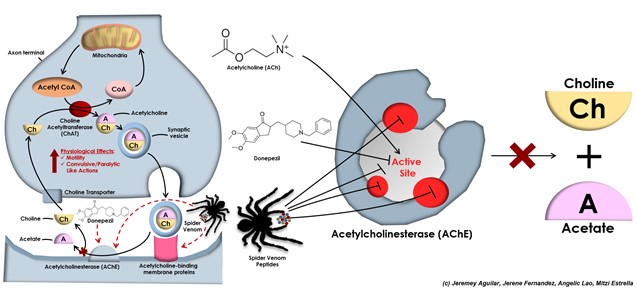Simon Miguel M. Lopez, Science Research Specialist I, Institute of Chemistry, College of Science, University of the Philippines-Diliman, Quezon City, Metro Manila, Philippines.
Mark Kevin P. Devanadera, MSc., PhD Student and Instructor, Department of Biochemistry, Faculty of Pharmacy, University of Santo Tomas (UST), Manila, Metro Manila, Philippines.
Myla R. Santiago-Bautista, LPT., PhD (cand), Assistant Professor, Department of Biochemistry, Faculty of Pharmacy, University of Santo Tomas, Manila, Metro Manila, Philippines, Curator and Faculty Lead Scientist, UST Mammalian Tissue Culture Laboratory, Research Center for Natural and Applied Sciences, Manila Philippines.
 Spiders use their venom primarily for prey capture and defense. The venom contains a cocktail of small molecules, proteins, and peptides known to target substances involved in the neuronal signaling pathway. Mainly, neuronal proteins such as acetylcholinesterase (AChE) and beta-secretase (BACE) are involved in neurotransmission and structural integrity of neurons, respectively. When aberrations occur in these proteins, cognitive and motor functions are impaired. In our study, “Neuroactive venom compounds obtained from Phlogiellus bundokalbo as potential leads for neurodegenerative diseases: insights on their acetylcholinesterase and beta-secretase inhibitory activities in vitro” published in the Journal of Venomous Animals and Toxins including Tropical Diseases (vol. 27), we presented the first evidence to demonstrate neuroactive and anti-AChE activities of the venom components from the Philippine tarantula, P. bundokalbo, for the generation of cholinergic compounds against neurological diseases.
Spiders use their venom primarily for prey capture and defense. The venom contains a cocktail of small molecules, proteins, and peptides known to target substances involved in the neuronal signaling pathway. Mainly, neuronal proteins such as acetylcholinesterase (AChE) and beta-secretase (BACE) are involved in neurotransmission and structural integrity of neurons, respectively. When aberrations occur in these proteins, cognitive and motor functions are impaired. In our study, “Neuroactive venom compounds obtained from Phlogiellus bundokalbo as potential leads for neurodegenerative diseases: insights on their acetylcholinesterase and beta-secretase inhibitory activities in vitro” published in the Journal of Venomous Animals and Toxins including Tropical Diseases (vol. 27), we presented the first evidence to demonstrate neuroactive and anti-AChE activities of the venom components from the Philippine tarantula, P. bundokalbo, for the generation of cholinergic compounds against neurological diseases.
The study was conducted by researchers of the University of Santo Tomas – Proteomics and Venomics (UST-ProVe) Group from the Department of Biochemistry, Faculty of Pharmacy and in collaboration with national and international institutions such as the Mindanao State University – Iligan Institute of Technology (MSU-IIT), Museum of Natural History of the University of the Philippines Los Baños (MNH-UPLB), Institute of Chemistry of the University of the Philippines Diliman (IC-UPD), and College of Staten Island – City University of New York (CSI-CUNY). MSU-IIT and MNH-UPLB conducted the collection and morphological identification of the tarantula. At the same time, UST-ProVe, IC-UPD, and CSI-CUNY made the top-down venomics approach in characterizing its venom components. In addition, in vitro biological analysis was carried out in the Mammalian Tissue Culture Laboratory of the University of Santo Tomas Research Center for Natural and Applied Sciences (UST-RCNAS).

Figure 1. Schematic hypothetical mechanism of spider venom inhibition on acetylcholinesterase (AChE) in vitro (right). The inhibition increases acetylcholine (ACh) neurotransmitters and their possible interaction with other neuronal membrane proteins, resulting in increasing motility, convulsive, and paralytic-like effects on worms in vivo (left). Image: LOPEZ, S. M. M., et al.
The article shows that P. bundokalbo venom contains diverse peptidic compounds that demonstrate neurological activity on mealworms in vivo and anti-AChE impact in vitro, not fully characterized from tarantula species to date. Thus, this suggests that novel venom compounds from this spider may interact with neuronal membrane proteins, which impair neuroactivity in insects. Furthermore, it also contains compounds that inhibit AChE, which is a known target for anti-neurodegenerative drugs. Optimistically, our findings suggest that the spider venom peptides could be exploited as therapeutic leads for diseases other than neurological diseases through biomedical and biotechnology research. Consequently, our study places value on Philippine spiders to ensure their environmental and social protection from illegal trade and poaching.
Further research is required to structurally elucidate the compounds present in spider venom using top-down or bottom-up methodologies despite the study promising neuroactivity results. This information would pave the way for large-scale chemical synthesis of its bioactive venom components to probe future applications in anti-cancer, anti-neurodegeneration, anti-pain, and pharmacokinetic research.
References
SANTIAGO-BAUTISTA, M. R., et al. Phlogiellus bundokalbo spider venom: Its neuroactive, phospholipase a2 and cytotoxic components against human breast adenocarcinoma (MCF-7). Phil J Health Res Dev [online]. 2021, vol. 25, no.01, pp. 36-48 [viewed 19 June 2021]. Available from: https://pjhrd.upm.edu.ph/index.php/main/article/view/398
MAYOR, A. B. R., et al. Phlogiellus bundokalbo spider venom: cytotoxic fractions against human lung adenocarcinoma (A549) cells. J Venom Anim Toxins Incl Trop Dis. [online]. 2020, vol. 26 [viewed 19 June 2021]. https://doi.org/10.1590/1678-9199-JVATITD-2019-0104. Available from: http://ref.scielo.org/8tzm5z
LOPEZ, S. M. M., et al. The venom of Philippine tarantula (Theraphosidae) contains peptides with pro-oxidative and nitrosative-dependent cytotoxic activities against breast cancer cells (MCF-7) in vitro. Asian Pac J Cancer Prev. [online]. 2020, vol.21, no.08, pp.2423-30 [viewed 19 June 2021]. https://doi.org/10.31557/APJCP.2020.21.8.2423. Available from: http://journal.waocp.org/article_89236.html
To read the article, acess
LOPEZ, S. M. M., et al. Neuroactive venom compounds obtained from Phlogiellus bundokalbo as potential leads for neurodegenerative diseases: insights on their acetylcholinesterase and beta-secretase inhibitory activities in vitro. J. Venom. Anim. Toxins incl. Trop. Dis [online]. 2021, vol. 27 [viewed 19 June 2021]. https://doi.org/10.1590/1678-9199-JVATITD-2021-0009. Available from: http://ref.scielo.org/rmz8m8
External links
Facebook – Journal of Venomous Animals and Toxins including Tropical Diseases: https://www.facebook.com/JVATiTD
Journal of Venomous Animals and Toxins including Tropical Diseases – JVATITD: http://www.scielo.br/jvatitd
Twitter – Journal of Venomous Animals and Toxins including Tropical Diseases: https://twitter.com/JVATiTD
UST Mammalian Tissue Culture Laboratory: https://www.facebook.com/USTMTCL
UST Proteomics and Venomics Group: https://www.facebook.com/UST-Proteomics-and-Venomics-Group-611915745832433/
Como citar este post [ISO 690/2010]:

















Recent Comments